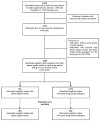Lower rate of cardiovascular complications in patients on bolus insulin analogues: a retrospective population-based cohort study
- PMID: 24244557
- PMCID: PMC3820645
- DOI: 10.1371/journal.pone.0079762
Lower rate of cardiovascular complications in patients on bolus insulin analogues: a retrospective population-based cohort study
Abstract
Background: Few studies are available evaluating the impact of rapid-acting insulin analogues on long-term diabetes outcomes. Our aim was to compare the use of rapid-acting insulin analogues versus human regular insulin in relation to the occurrence of diabetic complications in a cohort of diabetic patients through the analysis of administrative databases.
Methods: A population-based cohort study was conducted using administrative data from four local health authorities in the Abruzzo Region (900,000 inhabitants). Diabetic patients free of macrovascular disease at baseline and treated either with human regular insulin or rapid-acting insulin analogues were followed for a maximum of 3 years. The incidence of diabetic complications was ascertained by hospital discharge claims. Hazard ratios (HRs) and 95% CIs of any diabetic complication and macrovascular, microvascular and metabolic complications were estimated separately using Cox proportional hazard models adjusted for patients' characteristics and anti-diabetic drug use. Propensity score matching was also used to adjust for significant difference in the baseline characteristics between the two treatment groups.
Results: A total of 2,286 patients were included: 914 receiving human regular insulin and 1,372 rapid-acting insulin analogues. During the follow-up, 286 (31.3%) incident events occurred in the human regular insulin group and 235 (17.1%) in the rapid-acting insulin analogue group. After propensity score-based matched-pair analyses, rapid-acting insulin analogues users had a HR of 0.73 (0.58-0.92) for any diabetes-related complication and HRs of 0.73 (0.55-0.93) and 0.55 (0.32-0.96) for macrovascular and metabolic complications respectively, as compared with human regular insulin users. No difference between the two groups was found for microvascular complications.
Conclusions: Our findings suggest that the use of rapid-acting insulin analogues is associated with a lower risk of cardiovascular and metabolic complications compared with human regular insulin use.
Conflict of interest statement
Figures
Similar articles
-
Lower incidence of macrovascular complications in patients on insulin glargine versus those on basal human insulins: a population-based cohort study in Italy.Nutr Metab Cardiovasc Dis. 2014 Jan;24(1):10-7. doi: 10.1016/j.numecd.2013.04.002. Epub 2013 Jun 24. Nutr Metab Cardiovasc Dis. 2014. PMID: 23806740
-
Macro- and microvascular outcomes in patients with type 2 diabetes treated with rapid-acting insulin analogues or human regular insulin: a retrospective database analysis.Exp Clin Endocrinol Diabetes. 2014 Feb;122(2):92-9. doi: 10.1055/s-0033-1363684. Epub 2014 Feb 20. Exp Clin Endocrinol Diabetes. 2014. PMID: 24558019
-
Lower incidence of recorded cardiovascular outcomes in patients with type 2 diabetes using insulin aspart vs. those on human regular insulin: observational evidence from general practices.Diabetes Obes Metab. 2013 Apr;15(4):358-63. doi: 10.1111/dom.12035. Epub 2012 Nov 28. Diabetes Obes Metab. 2013. PMID: 23137345
-
(Ultra-)long-acting insulin analogues for people with type 1 diabetes mellitus.Cochrane Database Syst Rev. 2021 Mar 4;3(3):CD013498. doi: 10.1002/14651858.CD013498.pub2. Cochrane Database Syst Rev. 2021. PMID: 33662147 Free PMC article.
-
Fields of application of continuous subcutaneous insulin infusion in the treatment of diabetes and implications in the use of rapid-acting insulin analogues.Minerva Endocrinol. 2013 Sep;38(3):321-8. Minerva Endocrinol. 2013. PMID: 24126552 Review.
Cited by
-
Treatment with insulin analogs and prevalence of cardiovascular complications in patients with type 1 diabetes.Ther Adv Endocrinol Metab. 2017 Nov;8(11):149-157. doi: 10.1177/2042018817732732. Epub 2017 Oct 10. Ther Adv Endocrinol Metab. 2017. PMID: 29114384 Free PMC article.
-
Impact of comorbidity on the risk and cost of hospitalization in HIV-infected patients: real-world data from Abruzzo Region.Clinicoecon Outcomes Res. 2018 Jul 23;10:389-398. doi: 10.2147/CEOR.S162625. eCollection 2018. Clinicoecon Outcomes Res. 2018. PMID: 30087571 Free PMC article.
-
Predictors of new oral anticoagulant drug initiation as opposed to warfarin in elderly adults: a retrospective observational study in Southern Italy.Ther Clin Risk Manag. 2018 Oct 8;14:1907-1914. doi: 10.2147/TCRM.S171346. eCollection 2018. Ther Clin Risk Manag. 2018. PMID: 30349269 Free PMC article.
-
Comparison of Mortality and Major Cardiovascular Events Among Adults With Type 2 Diabetes Using Human vs Analogue Insulins.JAMA Netw Open. 2020 Jan 3;3(1):e1918554. doi: 10.1001/jamanetworkopen.2019.18554. JAMA Netw Open. 2020. PMID: 31977057 Free PMC article.
-
Prevalence of antibiotic prescription in southern Italian outpatients: real-world data analysis of socioeconomic and sociodemographic variables at a municipality level.Clinicoecon Outcomes Res. 2018 May 3;10:251-258. doi: 10.2147/CEOR.S161299. eCollection 2018. Clinicoecon Outcomes Res. 2018. PMID: 29765241 Free PMC article.
References
-
- The Diabetes Control and Complications Trial Research Group (1993) The effect of intensive treatment of diabetes on the development and progression of long-term complications in insulin-dependent diabetes mellitus. N Engl J Med 329: 977-986. - PubMed
-
- Temelkova-Kurktschiev TS, Koehler C, Henkel E, Leonhardt W, Fuecker K et al. (2000) Postchallenge plasma glucose and glycemic spikes are more strongly associated with atherosclerosis than fasting glucose or HbA1c level. Diabetes Care 23: 1830-1834. doi:10.2337/diacare.23.12.1830. PubMed: 11128361. - DOI - PubMed
Publication types
MeSH terms
Substances
LinkOut - more resources
Full Text Sources
Other Literature Sources
Medical



